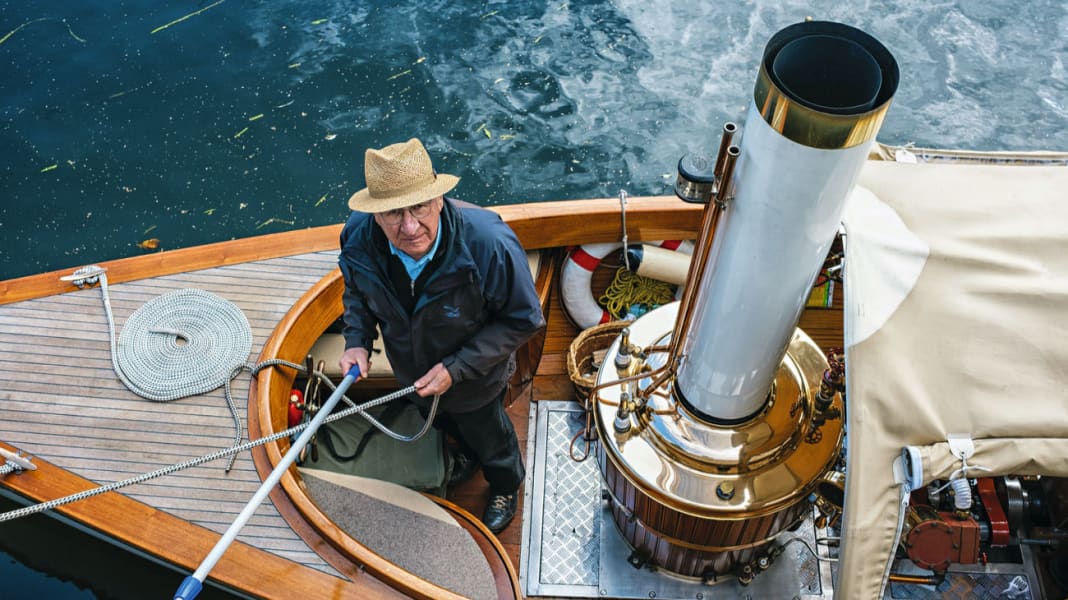
A piercing low whistle resounds through Eberswalde. Like a melody from days long gone. The many spectators who have gathered on the terraced steps of the small riverside promenade look expectantly towards the bend in the river. You can hear and smell them long before you see them. Finally, the first steamboat appears. "Here comes the 'Prometheus'! A beautiful wooden boat from Xanten on the Rhine, powered by a 2-cylinder compound engine from the USA." Joseph Schuck from the German Steamboat Association introduces the boats and their owners over a loudspeaker. This year's annual meeting of the association will take place on the historic Finow Canal, the oldest navigable artificial waterway in Germany. The canal has connected the Havel in the west with the Oder in the east for more than 400 years. It has been a good 100 years since steamboats were travelling here. The once important waterway in north-east Brandenburg is an insider tip: idyllic landscapes, lost industrial heritage, the forest town of Eberswalde and twelve historic locks provide variety and a chance to slow down. Just the thing for the "rediscoverers of slowness" with their steaming pieces of jewellery.
The smell wafting from the baked fish and smoked sausage stall mingles with the billows of smoke from the boat chimneys. One boat after another turns the corner and presents itself to the waving crowd. Children clap with delight as one of the owners pulls on the pipe line and lets off steam. The sight of the lovingly maintained, gleaming mechanics that once triggered the industrial revolution awakens nostalgic feelings, and not just among older spectators. The charming old-timers with their chimneys and simple, environmentally friendly technology also attract young families. On board the "Prometheus", Philipp and Ewald Hackenbruch are delighted with the spectators' interest. Father and son have shared their hobby for over 25 years.
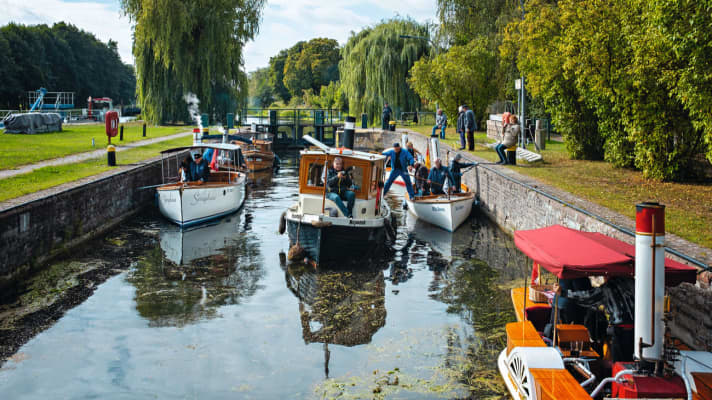
Steamboat drivers from all over Germany and Switzerland travelled to Brandenburg for the meeting. After a forced break of one and a half years due to corona, the joy of reuniting was particularly great this year. The association has been connecting steamboat enthusiasts for almost 40 years. When Hackenbruch restored the boat in the early 1990s, he was a great help: "You have to learn from others what mistakes they make so that you don't repeat them. The association is there to keep the know-how about the old technology alive, to help each other and to teach the next generation how to steam."
The home waters of the "Prometheus" are the Xanten lakes "North Sea" and "South Sea". It was originally intended to sail on the Rhine. That's why the decision was made in favour of the wide and low boiler, which has the advantage of less rocking compared to the narrow, higher boilers. "I also have to refire and regulate much less often," explains Hackenbruch, "so we have a little less space on board, but in an emergency I know that even if I let the fire go out, I can still travel a few kilometres." Dry beech wood and water - that's all a steamboat captain needs. And because they are so environmentally friendly, steamboats are even allowed to sail on drinking water lakes.
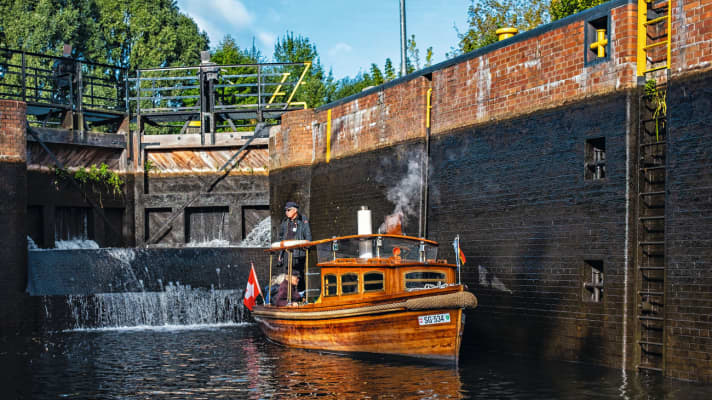
Special highlights are the meetings with other steamboat owners. "Once we were allowed to sail on the Binnenalster, together with the 'St. Georg', the oldest steamboat in Germany," enthuses Ewald Hackenbruch. He had been fascinated by steam engines since he was a child. In the seventies, he obtained a steam locomotive driving licence. "But a locomotive was too big, and you're a bit freer on canals than on rails, so I came to the steamboat."
The family enjoys the peace and quiet on board. That's what makes steamboating so appealing: the fact that the engine runs so quietly. And that there's always something to do. "You have to heat, you have to steer, you have to check the engine and the water level, and you can still see where the power comes from! This is tangible technology," explains Philipp Hackenbruch.
Unlike many others in the club, the Hackenbruchs are not passionate tinkerers, but rather enjoy driving. "Many here in the club are gifted mechanics and technicians," says Ewald Hackenbruch. "They build their boats themselves, their engines, and some even go so far as to build the boiler themselves. Great projects where the manufacturing process is actually the most important thing." He smiles: "Some really fear that it will be finished at some point and are then happy when they have something to screw after a few metres of sailing." One of these projects is the "Sunrise". Gerd Richter from Düren designed and built the hull, the engine and even the boiler himself. The retired technician and mechanical designer primarily wanted to build a hull when he happened to come across a trade magazine about steam engines in model making in the early 2000s. "I always thought it was more of a toy. Then I saw that it was real mechanical engineering. That gave me the idea of building a steam engine into the boat. That was the icing on the cake."
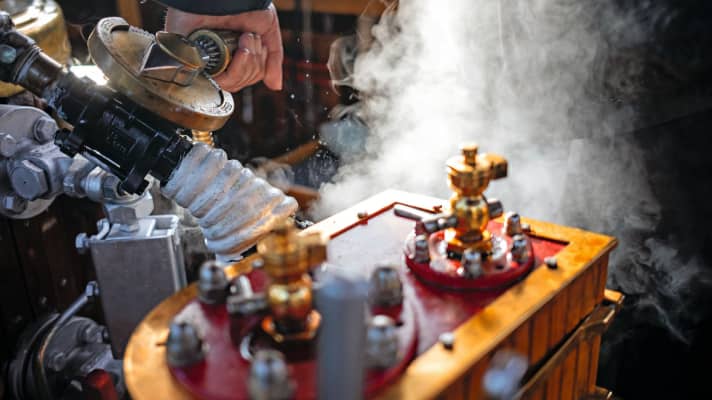
Gerd's wife Beatrix Richter enjoys the quiet pounding of the machine from the stern: "He asked me back then and I thought it was a great idea. He was working on the boat in the shed next to our house. So he was always close by. And now we enjoy the result together." It's in the nature of things that steam boating becomes a shared hobby in many families. You need at least two people on board. One steers, the other heats. The "Sunrise" glides through the open gates of the Eberswalde city lock, the oldest lock in Germany that is still in operation. The convoy bids farewell to the spectators on the city promenade and sets course for the quieter section of the day's route. When Gerd Richter talks about the construction and details of his engine, he is in his element: "The single-cylinder engine with around 2.5 hp is controlled by a round slide valve, but unlike other steam engines, it has a more modern design and is made entirely of corrosion-resistant material. We have high-performance plastics for the sliding bodies, piston rings and the slide bush, so we don't have to add oil to the steam. The whole thing is much cleaner! The exhaust steam, which is turned back into water via the outboard condenser, comes out completely clean, and then the pump takes the water for the boiler again without it having to go through several filter chambers to filter out the oil. I'm a bit of a revolutionary in the steam engine scene," says Richter with a wink and not without pride. "We don't need oil or grease on board. We only use wood for heating. No diesel, no coal!" He throws a few logs into the boiler and a few seconds later the temperature display rises to 350 degrees. The pressure rises to 7 bar and the boat immediately speeds up. In a convoy of steamboats, this means either overtaking the boat in front or letting off steam through the chimney. Richter opts for the first option and passes his Swiss colleague Konrad Müller on the "Penelopé" with a wave.
The Müller couple travelled all the way from Lake Zurich. Müller also designed his boat himself. The master mechanic worked on the plans for his boat in his company after work for six years. "After around 6,000 hours of work, it was finished," he says. "That's how the boat got its name. Because my wife waited for me every evening like Penelope for her Ulysses." In the smoke tube boiler from England, 100 smoke tubes filled with water lead upwards.
"The water level indicator is the most important thing on a steamboat," he explains, "Steam technology also has its dangers, and you have to be aware of them. If a boiler runs dry, it can be dangerous." The Müllers also prefer to use wood rather than coal because it is simply cleaner. The disadvantage: there isn't much space for bunkering at six by two metres. On average, the "Penelopé" needs around 10 kg of wood per hour. Elisabeth laughs: "I always say: If we want to go from Rapperswil to Zurich, i.e. once across the whole of Lake Zurich, we need three Ikea bags full of wood!" The Müllers are "fair-weather cyclists". As soon as the sun shines, they head out onto the water. Then they drop anchor, swim a lap around the boat and roast sausages in the kettle. Pure steam idyll.
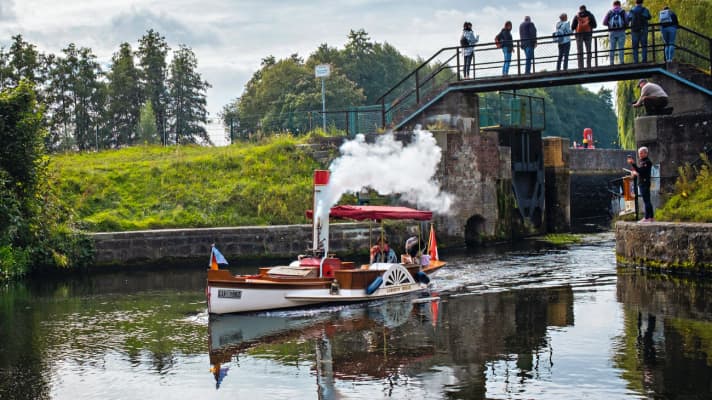
Andreas and Gertrud Scholz sometimes enjoy this deceleration for weeks on their "Nepomuk", the only boat in the club's fleet on which they also sleep and live. The boat, which is equipped with a galley, slip cabin and wet room, covers a good 600 kilometres a year. The 70-year-old American engine that Scholz has installed in the Dutch sloop once travelled on the Mississippi. In the past eight years, it has travelled the Moselle, Weser and even the Baltic Sea around Rügen and Usedom. The mechanical and welding engineer had previously spent eight years tinkering with the boat and designing the boiler in his spare time. Even as a teenager, he was fascinated by steam locomotives. A few years ago, the Scholz couple went on a boating holiday in France. "After I made a driving mistake, my wife took over the helm and didn't let go until the end of the trip!" says Andreas Scholz with a laugh. "She had so much fun and was so enthusiastic about boating. It was clear that we needed our own boat. And then it became clear relatively quickly that it had to be a steamboat. Then she can go boating and I can steam." It's quite cramped on the 7 x 2.50 metres when a huge boiler takes up most of the interior space. But thanks to the clear division of tasks, the two don't get in each other's way. "It's worked out really well. Everyone knows where they have to go. My wife is the skipper, I'm the engineer and stoker. I have no place at the helm."
The convoy passes the third lock and leaves Eberswalde behind. It passes lush green riverside vegetation that seems to be reclaiming the canal, so that you could almost forget that you are on an artificial waterway. The last boat to glide through the lock gate is a very special one: the "Liberty Belle", the smallest, but with an average of 1000 km per year, the most widely travelled boat in the fleet. At just 70 revolutions per minute, the only paddle steamer in the association is even more leisurely than the others. Almost as if in slow motion, the wave drives the paddle wheels on the sides. Martha and Beat Bolzern from Lucerne are on board with their boat dog Bella. Unimpressed by the hissing and whistling and the waving people on the shore, the eight-year-old Sheltie dog lies in her woven basket on the stern. From an early age, she has travelled with Martha and Beat on a wide variety of waters throughout Europe. From the Loire in the west to the Elbe in the east, from the Scottish lakes in the north to the Grand Canal in Venice. For the bridges of Venice, the smokestack of the "Liberty Belle" was made collapsible without further ado.
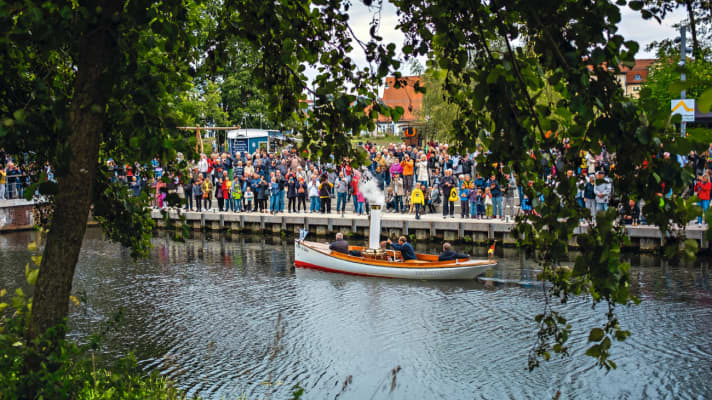
Martha and Beat Bolzern have shared two passions for over 30 years: travelling and a fascination for steam engines. For many years, they travelled all over the world, wherever steam locomotives still ran. When the era of steam locomotives came to an end, even in the last steam meccas of China and Africa, they came to a decision: "We said to ourselves, we'll just have to make steam ourselves! And we really wanted a paddle steamer." They searched the world for a year and a half until they finally found what they were looking for in 2004. Since then, they have customised the boat, which was built in England in 1987, several times to suit their needs. A second steering wheel near the steam engine now ensures that one of them can manoeuvre alone if necessary. A new steam engine and new paddle wheels have also made the boat safe for longer journeys.
At the mouth of the Finow Canal into the Oder-Havel Canal, "Europe's largest ship lift", the Niederfinow boat lift, appears on the port side as the last highlight of the tour. Then, after six days and 32 kilometres, the steamboat meeting comes to an end. On Lake Oderberg, things get a little more uncomfortable. Some of the narrow boats are really struggling. "Give it steam!", you can hear one of the captains shout against the wind. The last logs are thrown into the boilers and then it's full steam ahead for the final spurt.
More information? You can find the report "The rediscovery of slowness" with more pictures in BOOTE issue 03/2022 - available at newsagents from 16 February 2022 or online at Delius Klasing Shop.

